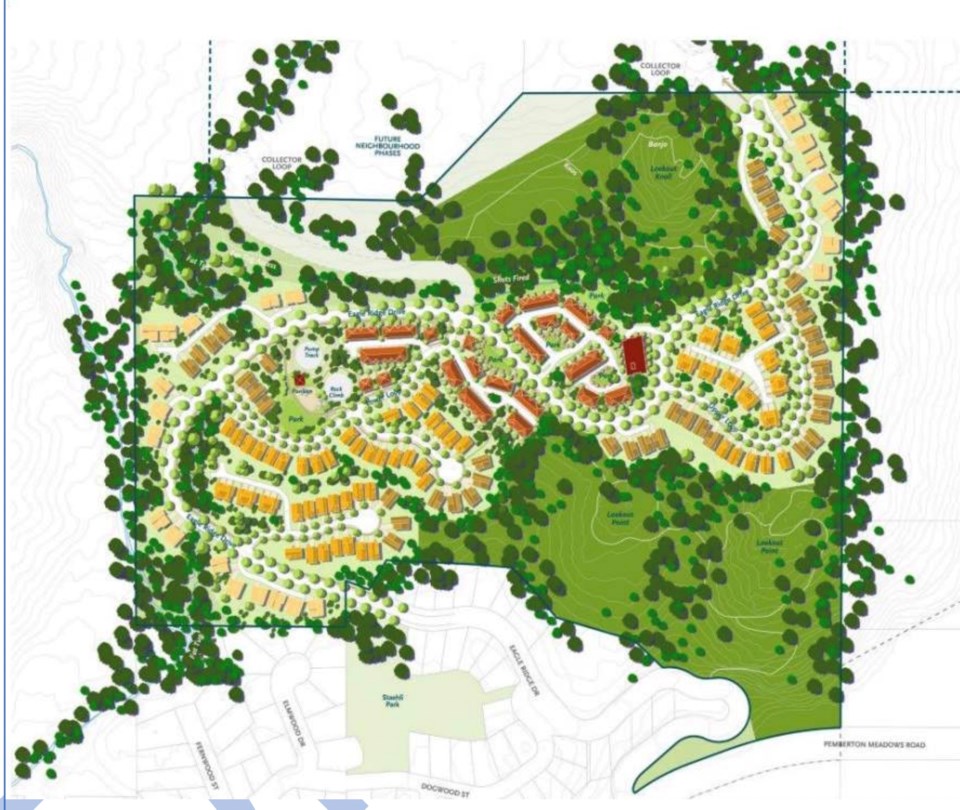As Pemberton continues to grow at breakneck speed, local officials are taking a hard look at the Village’s long-term future to ensure any new housing development in Spud Valley can meet the diverse housing needs of its expanding community.
At a Committee of the Whole meeting on March 14, one of the largest and most significant housing projects in Pemberton’s history took a major step towards that goal, when Village of Pemberton (VOP) mayor and council received a draft sub-area development plan for the proposed Nkwúkwma Benchlands project.
Consulting planner Cameron Chalmers broadly outlined the project at the meeting, and the next steps for VOP staff, council and the wider community to contribute to the final plan for the new residential neighbourhood.
“The sub-area plan represents a synthesis of all of the information that we’ve gathered over the last few years and then a projection of what that may look like in terms of policies and guidelines,” Chalmers said.
Led by Skénkenam Development LP, a partnership between the Lil’wat Nation’s Lil’wat Capital Assets and the Pemberton Benchlands Development Corporation, the proponents plan to develop 31.2 hectares (77.1 acres) of land—the largest remaining contiguous development site in the VOP—adjacent to Downtown Pemberton, over the next two decades.
The project’s first stage will yield up to 275 new housing units that, at build-out, could accommodate between 600 and 700 occupants over the next 10 years. Remediation work on the former Pemberton Gun Range—which led to “significant” contamination of lead and copper, the VOP said—will have to occur in a future stage to allow for the building of the remaining 175 planned units, for a total of 450 units, with capacity for between 1,200 and 1,350 new residents in the neighbourhood over the next 10 to 15 years.
The VOP first approved the Benchlands Neighbourhood Concept Plan in 2008, with the first houses constructed the following year. In 2017, the Lil’wat Nation began discussions with the province to acquire 60 hectares of Crown land in the neighbourhood, with the sale completed in 2021.
In the current iteration of the plan, duplexes and townhomes will comprise 43 per cent of the development, followed by single-family homes (42 per cent), with the remaining 15 per cent made up of apartment buildings. Altogether, housing will take up about 40 per cent of the total land area, with about half of the land reserved for natural areas and parks, and roughly one per cent dedicated to commercial and community uses.
According to Nkwúkwma Land Development manager Caroline Lamont, the mixture of densities proposed resulted from early community consultation, with affordability a significant priority for the development. “There’s some lots that can work with single-family or small-lot single-family [dwellings], and then others which might be better in a multi-family or a townhouse,” she said.
“The other point was the real increase in construction costs and the community’s affordability levels. So, we could do what Sunstone up there did, a lot of single-family [homes], but we believe that focusing on the smaller-lot, single-family duplexes and townhomes meets the market needs of the local community.”
Lamont pointed to smaller lots being easier for local contractors to develop, allowing for more of the project capital to be spent in the region. If the rezoning process continues as planned, the proponents hope to begin construction as early as spring 2024.
The sub-area plan estimates that if Pemberton grows by 6.48 per cent over the next five years, the population will increase to 4,501 people and, within 15 years, up to 11,232 people. To keep pace with this predicted population growth, an additional 400 homes must be constructed in the next five years, doubling to 800 in the next 15.
Pemberton’s population rose by a whopping 32.4 per cent between the 2016 and 2021 censuses, making it one of B.C.’s fastest-growing communities.
Pemberton Mayor Mike Richman said that while the proposal is in the early stages of community consultation, the location continues to make sense to develop, and that building a diversity of housing will help ease the Village’s affordability and vacancy challenges.
“There’s only so many areas we can develop in our valley in Pemberton, constrained by [the Agricultural Land Reserve], floodplain and geography. This was identified as a place that will allow for the natural growth of Pemberton, so, as we’ve talked about before, growth is inevitable. This is the reason that it’s so important to get the housing mix right,” he said.
“As we grow, we have to make sure that we’re bringing in the mixture of housing that will help deal with the affordability crisis that we have, that it’ll provide for all levels of populations. So, it will be a big factor in terms of how Pemberton grows. That’s why we want to get it right.”
The review of the draft plan marks the formal end of the information collection phase for the project and moves it closer towards the start of Phase 2, which is focused on policy and regulation development. This phase will also entail consultation from the community, council and local stakeholders.
VOP staff plans to host an open house next month with the proponents to get feedback from the community on the draft plan, with the date and time to be confirmed. Once council is satisfied with the draft plan, it will move into the final Official Community Plan and rezoning bylaws phase.
Residents can learn more about the draft plan online at haveyoursay.pemberton.ca.




